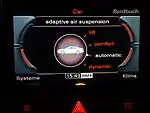Height adjustable suspension is a feature of certain automobile suspension systems that allow the motorist to vary the ride height or ground clearance. This can be done for various reasons including giving better ground clearance over rough terrain, a lower ground clearance to improve performance and fuel economy at high speed,[1] or for stylistic reasons. Such a feature requires fairly sophisticated engineering.

Height adjustment is most often achieved by air or oil compression used for the "springs" of the vehicle – when the pressure is varied – the vehicle body rises or lowers.
Factory systems for cars



The first instance of a production vehicle with adjustable (rear only) suspension was on the 1954 Citroën 15CVH. This vehicle featured a self-leveling, height adjustable hydropneumatic suspension. Since that time, these systems have appeared continuously on Citroën models, including the DS and CX.[2]
Height adjustable suspension was banned in the United States from 1974 to 1981, due to the stringent interpretation of passenger vehicle bumper height regulations by the U.S. government agency NHTSA. [3]
Subaru was one of a few manufacturers who offered the feature after the ban was lifted on the Subaru XT, the Subaru Leone wagon and the Subaru Legacy for a short time.
Many modern SUVs use height adjustability as part of active suspension systems to improve the vehicle's versatility on and off-road. [4] The Range Rover offered this feature from 1993. New models of the Ford Expedition have a computer-controlled system designed for convenience, which lowers automatically when the doors are unlocked by remote, returns to normal height when the vehicle is started, and (on 4-wheel-drive models), raises when the 4x4 system is engaged.[4]
Some cars use these systems to improve the vehicle's handling by lowering the vehicle's height during higher speeds – a current example being the Mercedes-Benz Active Body Control system. [4] Another example is the Audi A8, which when driven at speeds of more than 120 km/h for more than 30 seconds reduces its clearance from 120 mm to 95 mm.[5]
The new 2011 Jeep Grand Cherokee also includes adjustable suspension in the 4x4 model. It automatically lowers when the Park selection is engaged, and also lowers at high speeds to improve aerodynamics. It also allows drivers to manually raise the suspension for off-road situations.
Starting in 2012, the Tesla Model S and Tesla Model X offer their own patented height adjustable suspension as an option. Two goals are accomplished – the long, low slung car can be raised to avoid road obstacles – it also lowers at speed on the highway to improve aerodynamics.[4][6]
Factory systems for buses
Height adjustable air suspensions are also equipped on some buses, mainly "low-floor" city buses or "kneeling buses", however in recent years some high floor charter/intercity buses have been equipped with this feature as well. This allows the floor to be lowered when the bus is stopped, to allow people with large or bulky luggage, passengers with disabilities, or simply when stopping at stops with unusual curb arrangements to enter or exit the vehicle easily. It can also raise the bus more than normal, which is useful when navigating roads with large amounts of speed humps, crossing railway lines or in other unusual, but not always uncommon situations.
Assistive technology for persons with disabilities includes vehicles modified with height adjustable suspension, for example to allow wheelchair entry to the vehicle.
Aftermarket systems
In 1959, auto customizer Ron Aguirre scavenged the Pesco pumps and valves from a B-52 Bomber and adapted them to the front suspension of his X-Sonic bubble-topped custom car Corvette, allowing him to change the height of the car with a switch on the dashboard. [7] This was done to evade California law regarding ground clearance. [8]
Aguirre is commonly accepted as the first person to create a Lowrider car with hydraulically adjustable suspension.[9]
Another customizer, Gene Winfield, created The Reactor with height adjustable suspension in 1964, a car novel enough to guest star in several television programs. [10]

Adjustable suspensions have become intrinsically associated with lowrider vehicles. The popular image of these vehicles is of one "hopping" on its suspension, or sitting with one wheel completely off the ground.
These systems were initially adapted from the hydraulic pistons, valves and pumps used to adjust the flaps on aircraft. Today however, many aftermarket companies produce parts and equipment specifically designed for lowriders.
In recent years "air bag" systems (not to be confused with the air bag safety device) have been rapidly gaining popularity among car customizers. These air suspension systems use heavy-duty custom rubber "bags" to replace the stock shocks and springs, with either a compressor or tank of compressed gas used to raise and lower the vehicle at will.[4] Any light-duty truck, from a small suv Chevrolet S10 Blazer to a full-size truck such as Dodge Ram 3500, can be outfitted to adjust the vehicle so that the frame will lie on the ground when the air bags are deflated, or "Laid Out".
Trucks are also capable of "laying" the pinch weld of the body, or "Bodydrop" using a technique such as channeling the frame or building an entirely new frame.
User control
The first height adjustable suspension systems were controlled by the driver manually. [11]
With the development of computer controls, research is ongoing into electronic control of the height adjustment process. [12][13] Certain modern layouts allow electronics alone to make this decision without the driver's control, notably the Tesla Model S and Tesla Model X[6]
References
- ↑ Miller, Joseph (2007). Be Your Own Auto Repair Technician. Global Media. ISBN 978-81-904575-1-4.
- ↑ Mihnea Radu (September 30, 2012). "Citroen Hydropneumatic Suspension Explained". Autoevolution.
- ↑ Jack Solomon (March 1978). "Billion Dollar Bumpers". Reason.
- 1 2 3 4 5 "How Does Adjustable Suspension Work?". www.autoblog.com. Verizon Media. 17 Nov 2015. Retrieved 7 Aug 2020.
- ↑ "adaptive air suspension". Audi A8 Betriebsanleitung [Audi A8 Operating Instructions] (in German). Audi AG. 2008. p. 151.
- 1 2 Domenick Yoney (10 April 2018). "Let's Look At Tesla's Patented Self-Adjusting Air Suspension: This patent has its ups and downs". Inside EVs.
- ↑ "Going "Low and Slow" in East Los Angeles". The Golden State Company. Retrieved 24 August 2020.
- ↑ "Cruising into History under the Law's Nose". Michigan State University. Retrieved 24 August 2020.
- ↑ Rong, Blake (16 July 2016). ""Ghetto Famous" Lowriders Reach For The Sky In Odessa, Texas". Road & Track Magazine. Retrieved 24 August 2020.
- ↑ Jurnecka, Rory (28 Jun 2017). "These Two One-Off SoCal Customs Are Set to Invade Pebble Beach". www.automobilemag.com.
- ↑ "Suspension - V Height Corrector 3. Manual Height Control". citroen-ds-id.com.
- ↑ Zhihong Yin; Amir Khajepour; Dongpu Cao; Babak Ebrahimi; Konghui Guo (24 Feb 2012). "A new pneumatic suspension system with independent stiffness and ride height tuning capabilities". Vehicle System Dynamics. 50 (12): 1735–1746. Bibcode:2012VSD....50.1735Y. doi:10.1080/00423114.2012.660167. S2CID 110106627.
- ↑ Hyunsup Kim; Hyeongcheol Lee (Jun 2011). "Height and Leveling Control of Automotive Air Suspension System Using Sliding Mode Approach". IEEE Transactions on Vehicular Technology. Institute of Electrical and Electronics Engineers. 60 (5): 2027–2041. doi:10.1109/TVT.2011.2138730. S2CID 22122852.